The Joint Stock Company (JSC) Sukhoi Company is a major Russian, formerly Soviet, aircraft manufacturer, with its headquarters in Moscow, that designs both civilian and military aircraft. It was founded by Pavel Sukhoi in 1939 as the Sukhoi Design Bureau (OKB-51). In February 2006, the Russian government merged all Russian major aircraft design houses, the Sukhoi, Mikoyan, Ilyushin, Irkut, Tupolev, and Yakovlev as a new company named United Aircraft Corporation. Each design house had a standing of its own for decades and produced some of the world class aircraft during Soviet days. The Mikoyan (MiG) was the leading aircraft design house during the cold war. However, by 1980s, many Sukhoi aircraft had left Mikoyan behind. Today the Sukhoi stable includes top end fighters, civil aircraft and Unmanned aerial vehicles.
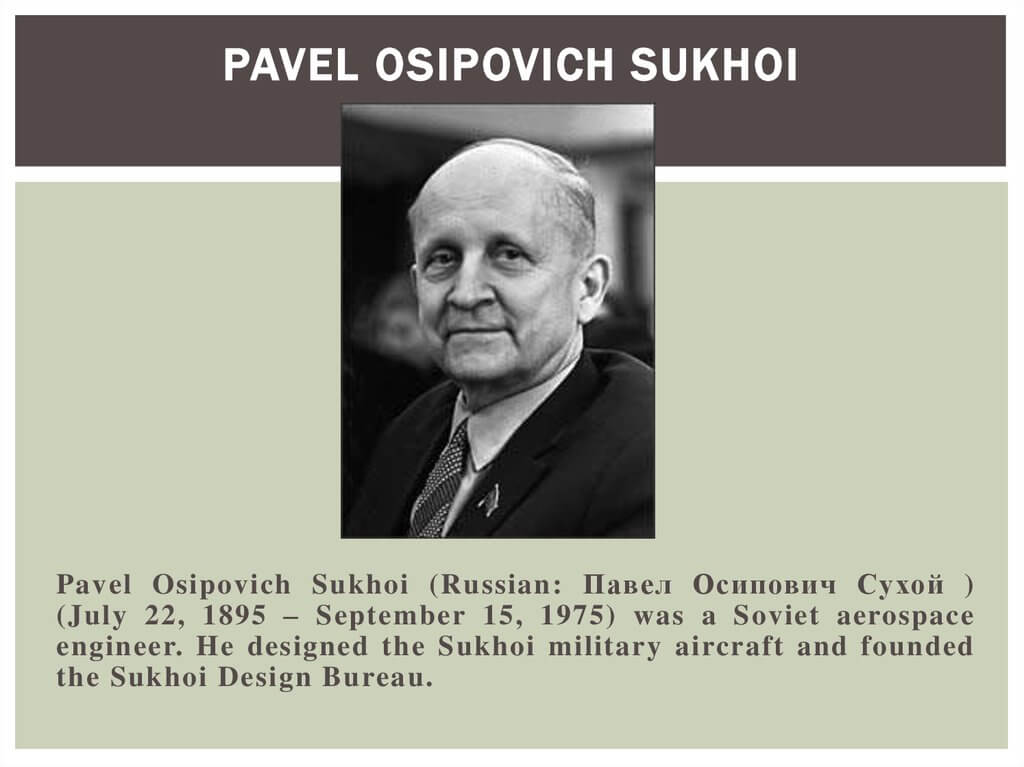
Origins in Late 1930s
In 1930, Pavel Sukhoi, an aerospace engineer took over “Team No. 4” of the CAHI’s AGOS aviation, a flying boat and aircraft prototype engineering facility. Under Sukhoi’s leadership, the team of the future design bureau started to take shape. The team, under the Tupolev OKB (Opytnoye Konstruktorskoye Buro, meaning Experimental Design Bureau), produced experimental fighters such as the I-3, I-14, and the DIP, a record-breaking RD aircraft, the Tupolev ANT-25, flown by famous Soviet aviators, Valery Chkalov and Mikhail Gromov. They also long-range bombers such as the Tupolev TB-1 and the TB-3.
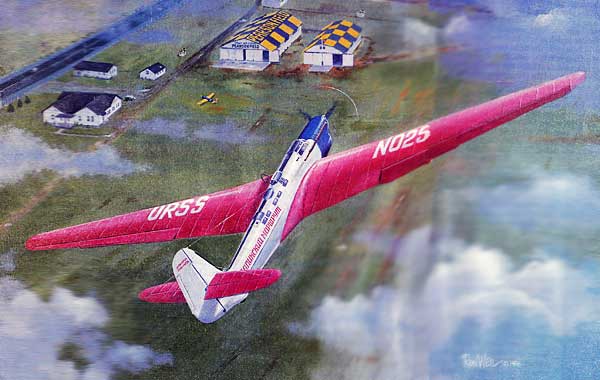
In 1936, Soviet leader Joseph Stalin, issued a requirement for a multi-role combat aircraft. Sukhoi and his team developed the BB-1, a reconnaissnace aircraft cum a light bomber in 1937. The BB-1 was approved and under a July 29, 1939 government resolution, the Sukhoi OKB, designated as OKB-51, also known as the Sukhoi Design Bureau, was formed in order to set up production for the aircraft. The BB-1 was introduced and later adopted by the Soviet Air Forces in the same year. A year later, the BB-1 was designated the Sukhoi Su-2. A total of 910 Su-2 aircraft were produced. The resolution also made Sukhoi chief designer, and the Sukhoi Design Bureau (SDB) standalone status. It was relocated to the Production Aircraft Plant No. 135 in Kharkiv, Ukraine. However, Sukhoi was not satisfied with its location, since it was isolated from the scientific pool of Moscow. Sukhoi later relocated the bureau to the aerodrome of Podmoskovye in Moscow, completing half of the relocation by 1940. The second issue for SDB was that there was no production line in Moscow.

World War II
During the German invasion of the Soviet Union, in World War II, the Su-2 needed a successor as it had already become obsolete and under-armed compared to German aircraft. Nearly 222 Su-2 aircraft were destroyed in initial days itself. SDB designed a two-seat armored ground-attack aircraft, the Sukhoi Su-6, which was considered in some terms to be superior to its competitor, the Ilyushin Il-2. The government, however chose the Il-2 over the Su-6, but rewarded Sukhoi a Stalin Prize of the 1st Level for its development in 1943. Sukhoi and this team later focused on development of variants of the Su-2, the prototype cannon-armed Sukhoi Su-3 fighter, as well as the Sukhoi Su-8, which was to serve as a long-range ground-attack aircraft for the Soviet Air Forces. It was however later discarded as the Soviet Union started winning the war in the Eastern Front.

Cold War Years
After WW II, SDB were among the first Soviet aircraft designers who led the work on jet aircraft, creating several experimental jet fighters. Sukhoi started developing two jet fighters, the Sukhoi Su-5 and Su-7 before 1945. The Su-5 was a mixed power jet fighter, using both a propeller and a motor jet to power it, but the experiment was later cancelled even though the fighter had a maiden flight on April 6, 1945. The Su-7 was a swept-wing, supersonic, air superiority fighter, turned out to be successful as it was adopted by the Soviet Air Forces in 1959, which was over 14 years after original design. At the start of 1945 itself, the SDB had started working on jet fighters such as the Sukhoi Su-9, Su-11, Su-15, and the Su-17 fighters. They were also working on Su-10 jet bomber, and the reconnaissance and artillery spotter twinjet, the Su-12. SDB also used the Tupolev Tu-2 bomber design to produce the trainer bomber UTB-2. SDB also began working on a passenger and troop-carrying aircraft, and a number of other aircraft designs.

From 1945 to 1950, SDB developed the Soviet Union’s first booster aircraft control system, landing braking parachute, catapult ejection seat with telescopic trolley, and a jettisonable nose with a pressurized cockpit. From 1949, Sukhoi fell out of Stalin’s favor and in a government resolution, the SDB was scrapped, and Sukhoi was forced to return to work under Andrei Tupolev, as Deputy Chief Designer. In 1953, the year of Stalin’s death, he was permitted to re-establish the SDB, set up with new production facilities.

Contemporary era
After the collapse of the Soviet Union, each of the multitude of bureaus and factories producing Sukhoi components was privatized independently. In the early 1990s, Sukhoi started to diversify its products and initiated Sukhoi Civil Aircraft to create a line of civil aviation projects for the company. The progress made by the new branch would lead to the development of the utility aircraft, the Su-80, and the agricultural aircraft, the Su-38. In 1996, the government re-gathered the major part of them forming Sukhoi Aviation Military Industrial Combine (Sukhoi AIMC). In parallel, other entities, including Ulan Ude factory, Tbilisi factory, Belarus and Ukraine factories, established alternate transnational Sukhoi Attack Aircraft , with plans to produce aircraft such as the Su-25TM.

The Sukhoi AIMC was composed of the JSC Sukhoi Design Bureau and the JSC Sukhoi Civil Aircraft, located in Moscow, the Novosibirsk Aircraft Production Association (NAPA), and the Komsomolsk-on-Amur Aircraft Production association (KnAAPO). Sukhoi was headquartered in Moscow. Finmeccanica (since 2017, Leonardo) owns 25% + 1 share of Sukhoi’s civil division. The Russian government merged Sukhoi with other major aircraft production houses into the newly formed company United Aircraft Corporation in February 2006. Mikoyan and Sukhoi were placed within the same operating unit. In September 2007, Sukhoi launched its first modern commercial regional airliner, the Superjet 100 (SSJ 100), a 78 to 98 seater, built by Sukhoi. The maiden flight was made on May 19, 2008. In March 2008, Sukhoi was selected to design and produce the carbon fibre composite wings for Irkut’s MC-21 airliner’s airframe. The aircraft did its maiden flight on 28 May 2017. Sukhoi is also working Russia’s fifth-generation stealth fighter, the Sukhoi Su-57. The maiden flight of which took place on the 29 January 2010. Sukhoi is working on a family of the regional airliners including the Superjet 130.

Sukhoi Fighter Aircraft
| Aircraft | Role | Total Built | Maiden Flight | Service Entry | Years of Production | Retired |
| Su-2 | Recce, Light Bomber | 910 | 25 Aug 1937 | 1939 | 1937-42 | 1944 |
| Su-7 | Ground Attack | 1,847 | 07 Sep 1955 | 1959 | 1957-72 | |
| Su-9 | Interceptor, looked like MiG 21 | 1,150 | 24 June 1959 | 1959 | 1959-Late 1960s | 1979 |
| Su-11 | Interceptor | 108 | 25 Dec 1958 | 1964 | 1962-1965 | 1983 |
| Su-15 | Interceptor | 1,290 | 30 May 1962 | 1965 | 1965-79 | 1996 |
| Su-17/Su-20/Su-22 | Variable Wing Ground attack | 2,867 | 02 Aug 1966 | 1970 | 1969-90 | |
| Su-24 | Variable Wing Attack Aircraft | 1,400 | 02 July 1967 | 1974 | 1967-93 | |
| Su-25 | Close air Support | 1,000+ | 22 Feb 1975 | 1981 | 1978-Present | |
| Su-27 | Multi Role Air Superiority | 809 | 20 May 1977 | 1985 | 1982-Present | |
| Su-33 | Carrier Based Multi Role | 35 | 17 Aug 1987 | 1998 | 1987-99 | |
| Su-30 | Multi Role | 540+ | 31 Dec 1989 | 1996 | 1992-Present | |
| Su-27M/Su-35 | Multi Role Air Superiority | 75 | Su-27M 28 June 1988 Su-35S 19 Feb 2008 | 2014 | Su-27M 1988-95 Su-35S 2007-Present | |
| Su-30 MK-2/Su-30MKK | Multi Role Air Superiority China | 134 | Su-30Mk 01 July 1997 | 2002 | 2000-Present | |
| Su-30 MKI | Air Superiority India | 260 | 2000 | 2002 | 2000-Present | |
| Su-80 | STOL Transport | 8 | 04 Feb 2001 | 2001 | 2001-Present | |
| Su-34/Su-32 | Fighter Bomber | 102 | 13 Apr 1990 | 2014 | 2006-Present | |
| Su-30 MKM | Multirole Malaysia | 18 | July 1997 | 2007 | 2007-Present |
Sukhoi Civil Aircraft
| Aircraft | Role and Total Built | Maiden Flight |
| Su-26 | Aerobatics | 1984 |
| Su-29 | Aerobatics | 1991 |
| Su-31 | Aerobatics 153 (All Three Types) | 1992 |
| Su-80 | STOL 30 seat (8) | 2001 |
| Superjet 100 | Regional jet 100 seat (136) | 2008 |
Current Experimental aircraft
The Sukhoi Su-57 is a stealth, single-seat, twin-engine, multirole, fifth generation jet fighter being developed since 2002 for air superiority and attack missions. The aircraft is the product of the PAK FA (prospective aeronautical complex of front-line air forces’), a fifth generation fighter program of the Russian Air Force. Sukhoi’s internal name for the aircraft is T-50. The Su-57 is planned to be the first aircraft in Russian military service to use stealth technology. Its maiden flight took place on 29 January 2010 and the first production aircraft were delivered in early 2020. The fighter is designed to have super-cruise, super maneuverability and advanced avionics. The Su-57 is intended to replace MiG-29 and Su-27 in the Russian Air Force. The prototypes and initial production batch are with a highly upgraded Lyulka AL-31 variant engine, the AL-41F1, as an interim power-plant while an advanced clean-sheet design engine, currently designated the izdeliye 30, is currently in final stages of development and expected to be available after mid-2020s. The aircraft is expected to have a service life of up to 35 years.

Planned aircraft
The Sukhoi S-54 was a series of three closely related aircraft proposals; the S-54 (Trainer aircraft), S-55 (light fighter) designed for export, and the S-56 carrier-capable light fighter. All members of the family resemble the Su-27 in general form, or the Su-33 more closely, but built around a single Saturn AL-31 engine instead of two, and scaled down accordingly to a smaller layout. The design was offered to several potential customers, including South Africa and India but was turned down. Development is apparently on hold, awaiting a launch customer. Sukhoi Superjet 130. Many different seat variants of the Sukhoi Superjet-100 regional airliner are being evolved.
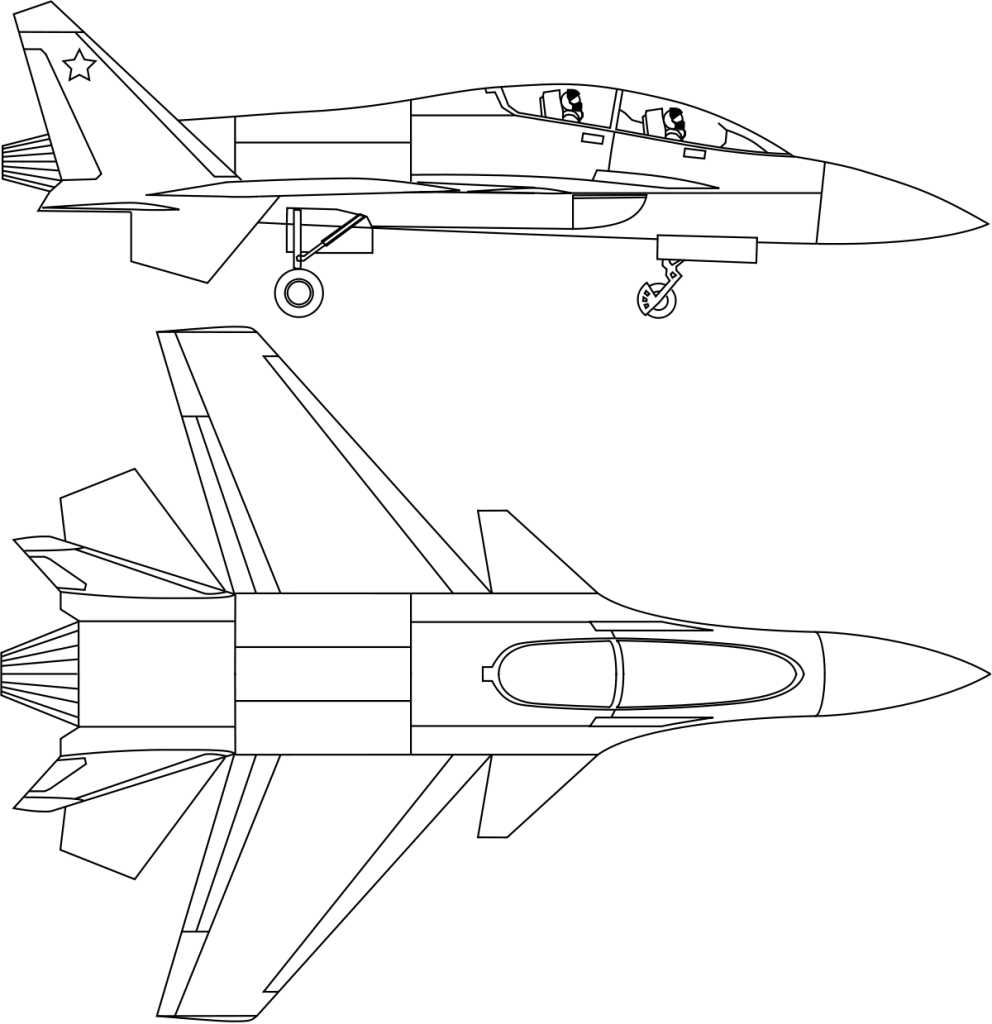
United Aircraft Corporation
After the sudden collapse of Soviet Union in 1991, the Russian aerospace industry was in turmoil. The military aircraft industry was able to benefit from export of a large storage of components and parts since Soviet times. For example, in 1990, Russia produced 715 aircraft. 8 years later, in 1998, that number decreased to only 56 aircraft. In 2000, only 4 civilian aircraft were produced. In order to solve this, a phase of industry consolidation began. The VPK-MAPO (Military Industrial Complex – Moscow Aircraft Production Association), which included companies such as Mikoyan was created. The consolidation wasn’t successful and MAPO later merged with Sukhoi. The UAC was created on 20 February 2006 by merging Sukhoi, Mikoyan, Ilyushin, Irkut, Tupolev, and Yakovlev to form a new company named United Aircraft Corporation.
The PJSC United Aircraft Corporation (UAC) is a Russian aerospace and defence corporation. With a majority stake belonging to the Russian Government. It consolidates Russian private and state-owned aircraft manufacturing companies and assets engaged in the manufacture, design and sale of military, civilian, transport, and unmanned aircraft. Its headquarters is in Moscow. Many of the corporation’s assets are located in various regions in Russia, with joint-ventures with foreign partners in Italy, India and China. UAC 100,000 employees. Its 2017 revenue was US $7.5 billion.

In February 2007, the UAC presented its first aircraft and the first military aircraft designed and exported under the UAC brand, the Mikoyan MiG-35. The MiG-35 is a was a contender for its fourth generation counterparts in the Indian MMRCA competition but was taken out of the competition in April 2011.

In February 2008, the UAC brought out an improved version of the Sukhoi Su-27, the Sukhoi Su-35S, also called the Su-35BM, which was to serve as the interim aircraft for the upcoming Sukhoi PAK FA fifth generation aircraft. This is the second modernized version of the Su-27, where the first modernized version took place back on 28 June 1988, designated as the Sukhoi Su-27M, also known as the Su-35. The improved aircraft includes a reinforced airframe, air-thrusted engines, radar, and improved avionics, while excluding canards and an air brake. The Russian Air Force designated it as the Su-35S and ordered 98 units with additional orders from China and Indonesia. Sukhoi thought sales of the Su-35S would go over 160 but they are blunted by updated versions of the Su-30.
In May 2008, the UAC presented its third aircraft and the first airliner designed and exported under the UAC brand, the Sukhoi Superjet 100 (SSJ 100). The SSJ 100 is the fourth civilian aircraft and the first airliner to be made by Sukhoi. Before, Sukhoi and Boeing had made an agreement and where Boeing consultants would help and advice Sukhoi on the airliner. In 2009, UAC delivered 90 aircraft, including 17 passenger aircraft, 31 MiG-29 and two Su-34. On 29 January 2010, Sukhoi and the UAC revealed the PAK FA. In 2013, nine aircraft repair plants of the Russian Ministry of Defence were transferred under the ownership of the UAC. As a result, in 2014, the serviceability of the Russian Air Force increased from 40% to 65%.

On 1 September 2017, the UAC Board decided to merge Sukhoi Civil Aircraft and the Irkut Corporation into a Civil Aviation Division on the basis of Irkut Corporation. In turn, Sukhoi will become the financial basis of all civil aircraft produced by UAC.
Sukhoi Su-7 in India
The Sukhoi Su-7 was a swept wing, supersonic fighter aircraft developed by the Soviet Union in 1955. Originally, it was designed as a tactical, low-level dogfighter, but was not successful in this role. On the other hand, the soon-introduced Su-7B series became the main Soviet fighter-bomber and ground-attack aircraft of the 1960s. The Su-7 was rugged in its simplicity but its shortcomings included short range and light weapon load. The first prototype, designated S-1, was designed to use the new Lyulka AL-7 turbojet engine. It was the first Soviet aircraft to utilize the all-moving tail-plane and a translating center-body, a movable inlet cone in the air intake for managing airflow to the engine at supersonic speeds. The aircraft also had a dramatic wing sweep of 60°, irreversible hydraulically boosted controls, and an ejection seat of OKB’s own design.

The S-1 first flew on 7 September 1955 with test pilot A. G. Kochetkov at the controls. Fitted with an afterburner version of the AL-7 engine after the first eleven flights, the prototype set a Soviet speed record of 2,170 km/h (Mach 2.04) in April 1956. The prototype was intended to be armed with three 37 mm cannons and 32 spin-stabilized 57 mm unguided rockets in a ventral tray. The second prototype, S-2, introduced some aerodynamic refinements. Only 132 S-1 were produced between 1957 and 1960, and the aircraft entered service as Su-7 in 1959.

Sukhoi was tasked by the Russian Air Force to develop a ground-attack variant of the Su-7, which could replace the scrapped Ilyushin Il-10. The resulting prototype, S-22, incorporated structural refinements for high-speed, low-altitude operations. It first flew in March 1959, and entered service in 1961 as the Su-7B. Operationally, Su-7s were hampered by a high landing speed of 340–360 km/h, as dictated by the thin, highly-swept wing. Combined with poor visibility from the cockpit, and lack of an instrument landing system. In 1961–1962, Sukhoi experimented with blown flaps on S-25 but the benefit was too small to warrant implementation. The JATO rockets tested on S-22-4 proved more useful and were incorporated into Su-7BKL. Attempts to improve takeoff and landing performance eventually resulted in the Su-17. Su-7A fighter version saw limited operational use and by 1959, a decision was made to proceed with production of the MiG-21, and less than 200 units were deployed. The Su-7A was retired in 1965.
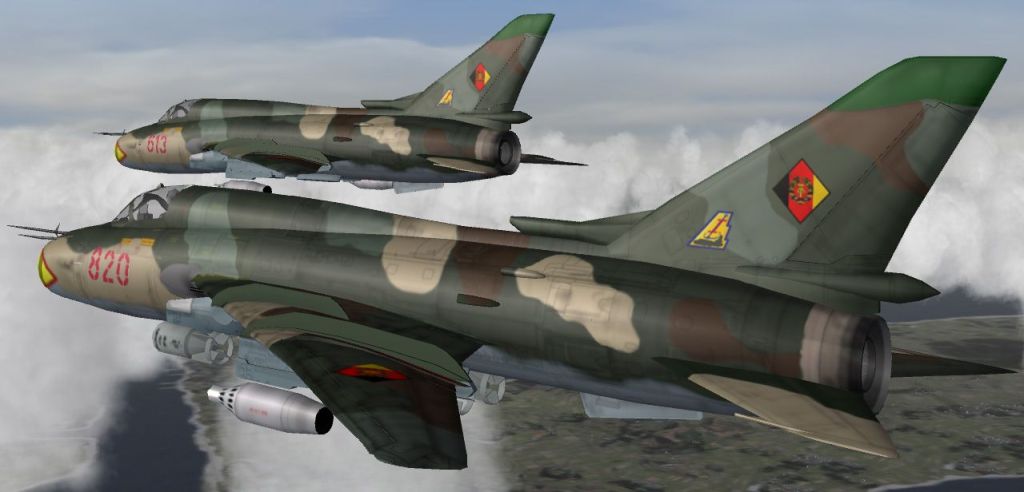
Su-7B and its variants became the main Soviet ground-attack aircraft of the 1960s. They were also widely exported (691 planes, including some trainers). However, the very short combat radius and need for long runways limited its operational usefulness. On the other hand, despite its notoriously heavy controls, the Su-7 was popular with pilots for its docile flight characteristics, simple controls and considerable speed even at low altitudes. It also had a reputation for easy maintenance. In 1977–1986 the Su-7s remaining in Soviet service were replaced by Su-17 and MiG-27.
The Indian Air Force (IAF) used the Su-7 extensively in the 1971 war with Pakistan. Six squadrons, totaling 140 aircraft, flew almost 1,500 offensive sorties during the war, and undertook the bulk of the daytime attack efforts. The IAF managed to retain a very high operational tempo with its Su-7s, peaking at a sortie rate of six per pilot per day. Fourteen Su-7s were lost during the war, mostly due to AA fire. After the war, it was found that the aircraft had a high survivability, being able fly home safely despite receiving heavy damage. For example, Wing Commander H. S. Mangat’s Su-7 was badly damaged by a Sidewinder missile fired from a Pakistani J-6. The impact was so severe that half the rudder was missing, the elevators, ailerons and flaps were severely damaged, and half the missile was stuck in the chute pipe. The pilot made it back to his base. Indian Su-7BMK shot down at least two Shenyang J-6 in the 1971 war, while losing 3 Su-7 to the J-6. Su-7BMK was a simplified export version of Su-7BM. Manufactured 1967–1971 with 441 built.

The SU-30 MKI
The Su-30MK was designed by Russia’s Sukhoi Corporation beginning in 1995. The Sukhoi Su-30MKI is the India specific variant. It is a twinjet multirole air superiority fighter and built under license by India’s HAL for the IAF. This variant of the Su-30 is a heavy, all-weather, long-range fighter. The first Russian-made Su-30MKI variant was joined IAF in 2002, while the first Su-30MKI assembled in India entered service with the IAF in 2004. The Su-30MKI is more advanced even than the Chinese Su-MKK/MK2. Russians were so impressed with the MKI that they ordered 30 Su-30SMs, a localised Su-30MKI, for the Russian Air Force. It features state of the art avionics developed by Russia, India and Israel for display, navigation, targeting and electronic warfare; France and South Africa provided other avionics. The IAF has nearly 260 Su-30MKIs in inventory as of January 2020. The Su-30MKI is already the backbone of the Indian Air Force’s fighter fleet to 2020 and will see through another 25 years or so. The aircraft is tailor-made for Indian specifications and integrates Indian systems and avionics as well as French and Israeli sub-systems. It has abilities similar to the Su-35 with which it shares many features and components.

The initial contract was signed on 30 November 1996, for US$1.462 billion for 50 Russian-produced Su-30MKIs in five batches. The first batch were eight Su-30MKs, the basic version of Su-30. The second batch were to be 10 Su-30Ks with French and Israeli avionics. The third batch were to be 10 Su-30MKIs featuring canard fore planes. The fourth batch of 12 Su-30MKIs and final batch of 10 Su-30MKIs were to have the AL-31FP turbofans.

An estimated 920 AL-31FP turbofans were to be manufactured at HAL’s Koraput Division, while the mainframe and other accessories were to be manufactured at HAL’s Lucknow and Hyderabad divisions. Final integration and test flights of the aircraft are carried out at HAL’s Nasik Division. Four manufacturing phases were outlined with progressively increasing Indian content. In phase I, HAL manufactured the Su-30MKIs from knocked-down kits, transitioning to semi knocked-down kits in phase II and III; in phase IV, HAL produced aircraft from scratch from 2013 onwards.

In 2007, another order of 40 Su-30MKIs was placed. In 2009, the planned fleet strength was to be 230 aircraft. In June 2010, CCS cleared the ₹15,000 Crore (US$2.1 billion) deal and that the 42 aircraft would be in service by 2018. On 24 December 2012, India ordered assembly kits for 42 Su-30MKIs by signing a deal during President Putin’s visit to India, This increased India’s order total to 272 Su-30MKIs. In June 2018, India has reportedly decided not order any further Su-30s as they feel its cost of maintenance is very high compared to Western aircraft. In June 2020 India decided to place an order for 12 more Su-30MKI aircraft along with 21 MiG-29s. The Su-30MKI order is to compensate for losses due to crashes to maintain the sanctioned strength of 272 Su-30MKIs.

Su 30 MKI Upgrades and Years of Work
In 2004, India reportedly signed a deal with Russia to domestically produce the Novator K-100 missile, designed to shoot down (AEW&C) and C4ISTAR aircraft, for the Su-30MKI. Although not initially designed to carry nuclear or strategic weapons, India has considered integrating an air-launched version of the nuclear-capable Nirbhay. In May 2010, media reported that Russia had won a contract to upgrade 40 Su-30MKIs with new radars, onboard computers, electronic warfare systems, and the ability to carry the BrahMos cruise missile. The first two prototypes with the “Super-30” upgrade will be delivered to the IAF in 2012, after which the upgrades will be performed on the last batch of 40 production aircraft. The BrahMos missile integrated on the Su-30MKI will provide the capability to attack ground targets from stand-off ranges of around 300 km. On 25 June 2016, HAL conducted the first test flight of a Su-30MKI fitted with a BrahMos-A missile from Nashik, India. The first air launch of BrahMos from a Su-30MKI was successfully carried out on 22 November 2017.

India is planning to upgrade its Su-30MKI fighters with Russian Phazotron Zhuk-AE AESA radars. The X band radar can track 30 aerial targets in the track-while-scan mode and engage six targets simultaneously in attack mode. In 2011, India issued a request for information to MBDA for the integration of the Brimstone ground attack missile and the long-range Meteor air-to-air missile. In February 2017, it was reported that the planes would be upgraded with AL-41F turbofan engines, same as the ones on Su-35. In August 2017, the Indian government cleared a proposal of Rs. 30,000 Crore to equip the planes with new reconnaissance pods. India is planning to increase Su-30MKIs BVR engagement capability by arming its entire fleet with the indigenous Astra BVR missile having a range of over 100 km, and Israeli Derby after it was found that the R-77 active-radar homing BVR missile has inadequate performance. In September 2019, the Astra was in multiple user-trials by Indian Air Force to validate its lethality for the Su-30MKI.
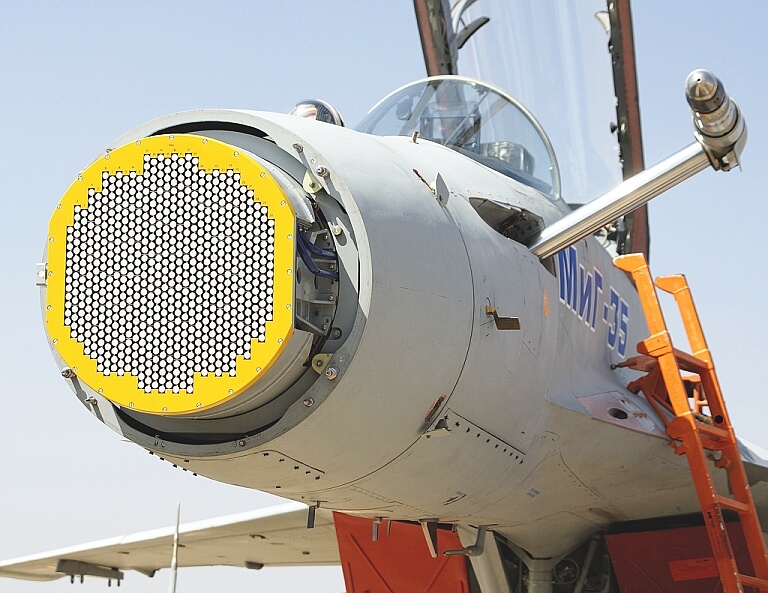
The Su-30MKI has a range of 3,000 km with internal fuel which ensures a 3.75 hour combat mission. Also, it has an in-flight refueling (IFR) probe that retracts beside the cockpit during normal operation. The air refueling system increases the flight duration up to 10 hours with a range of 8,000 km at a cruise height of 11 to 13 km. Su-30MKIs can also use the Cobham 754 buddy refueling pods. Su-30 MKI has 12 external hard-points. 2 × wing-tip AAM launch rails, 6 × pylons under-wing, 2 × pylon under-engine nacelles, and 2 × pylons in tandem in the “arch” between the engines. It can be increased to 14 using multiple ejector racks. The maximum capacity is up to 8,130 kg (17,920 lb).

On 27 February 2019, next day after 2019 Balakot airstrike, two Su-30MKI on Combat Air Patrol (CAP) were attacked by multiple Pakistani F-16s using AMRAAM AIM 120 missiles. All of the missiles were successfully evaded. The 272 aircraft in inventory, and 12 more planned, would mean around 13 squadrons.
The Sukhoi Su-30MKI is the most potent fighter jet in service with the IAF and is often fielded by the IAF in bilateral and multilateral air exercises. Many have praised the MKI’s dogfight ability, calling it “absolutely masterful in dogfights”. India will be closely connected to the Team Sukhoi, albeit part of UAC. With the upgraded Su-30 MKI expect at least a 30 years more together.
PAKFA – FGFA
The Sukhoi/HAL Fifth Generation Fighter Aircraft (FGFA) or Perspective Multi-role Fighter (PMF) was planned as a fifth generation fighter aircraft, based on the Russian PAKFA/T-50 (Now Sukhoi Su-57). While the program was earlier called FGFA, the combined project is now referred as Perspective Multi-Role Fighter (PMF). The completed FGFA was to include a total of 43 improvements over the Su-57, including advanced sensors, networking and combat avionics. The Indian version would be also a two-seater with pilot and co-pilot or weapon systems operator (WSO). The major objections which led to the contract falling through were poor build quality, poor engine reliability and not meeting IAF specific QRs. Also while India was paying 50 per cent of the project money, the work share for HAL was only 15 per cent or so.

Reports indicated that India withdrew from the FGFA program in 2018, but also hinted that the project could be resumed at a later date, when the Su-57 is fully operational in the Russian Air Force first. Russians have repeatedly stated that the project is still open. However, in October 2019, the Indian Air Force Chief of Air Staff RKS Bhadauria stated that the country will not be importing stealth fighters like the Su-57, and will instead focus on indigenous efforts such as the HAL AMCA.
Lead Picture Credit: defenceaviationpost.com


19 thoughts on “Sukhoi – The Great Aircraft Design House – Some of The Best Airborne Platforms”